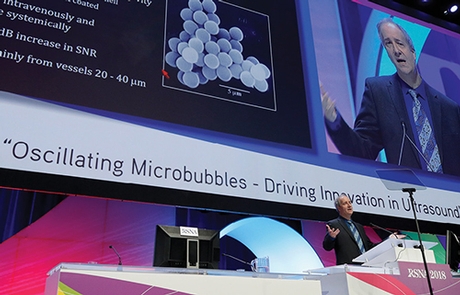A novel class of ultrasound (US) contrast agents is expanding the possibilities of the modality in cancer treatment and other areas of medicine, according to a leading researcher in the field who spoke Tuesday in the Arie Crown Theater.

Forsberg
Flemming Forsberg, PhD, professor of radiology at Thomas Jefferson University in Philadelphia, began his New Horizons lecture, "Oscillating Microbubbles — Driving Innovation in Ultrasound," by declaring himself "a huge fan of bubbles."
"Why we love them, apart from the fact that you need bubbles for champagne," he said, "is because they give us up to a 30-decibel increase in our signal-to-noise ratio and they give us an order of magnitude better depiction of vascularity."
Microbubbles — gas-filled bubbles smaller than a red blood cell — are well-established vascular tracers and contrast agents for US imaging. They can be made to oscillate and burst by increasing the amount of acoustic pressure applied by the transducer. This ability has opened up many new avenues of research, Dr. Forsberg said.
Through the technology of subharmonic imaging (SHI), microbubbles can be used as pressure sensors, a discovery that led the way to the development of a noninvasive pressure measurement technique known as subharmonic-aided pressure estimation (SHAPE).
Noninvasive SHAPE measurements may be a useful alternative to catheter-based measurements of cardiac conditions. They can help noninvasively predict portal hypertension, a condition in which blood pressure is too high in the vein that carries blood to the liver.
Oscillating microbubbles have shown promise as an early predictor of the effectiveness of chemotherapy in breast cancer, sparing patients the unpleasant side effects of an ineffective drug cocktail. The technique takes advantage of the fact that interstitial fluid pressure is higher in a tumor than in normal tissue. In one study, SHAPE was able to predict treatment response with 100 percent accuracy after just one round of chemotherapy.
Tumor hypoxia, or oxygen deprivation, has been known to limit radiation therapy's effectiveness, so researchers hatched the idea of delivering oxygen-filled microbubbles to the site of a tumor and then destroying them, releasing the oxygen into the tumor. In a study of 50 mice, the combination of oxygen delivery and radiation therapy significantly increased tumor volume control.
The FDA has not yet approved this approach in humans, so researchers have been studying US-targeted microbubble destruction (UTMD) as a more immediate option.
Early Phase of Clinical Trial is Promising
Dr. Forsberg and colleagues are in the early phase of a clinical trial studying UTMD on liver cancer patients undergoing radioembolization. The researchers introduced the microbubbles into the tumor and then destroyed them with acoustic waves, making the tumor more sensitive to the radiation. Follow-up imaging showed that of the seven patients who underwent UTMD, two experienced complete response to treatment and four had partial response. In contrast, of the four patients who did not get UTMD, only one had partial response and three had no response at all.
"We are about a quarter of the way into our ongoing clinical trial, but we think these preliminary efficacy results show us that there is potential for this to work," Dr. Forsberg said.
Oscillating microbubbles are also being studied as a way to deliver drugs to the brain through the almost impermeable blood-brain barrier. Research out of the University of Toronto on five Alzheimer's disease patients showed that microbubbles could be used to safely, reversibly and repeatedly open the barrier. The researchers now want to attempt drug delivery through the temporary opening.
In Norway, scientists found that by applying vibrations to microbubbles, they could improve the effectiveness of chemotherapy in pancreatic cancer patients. The patients were able to tolerate more treatments, and median survival increased from nine months to 17 months.
"There are a number of therapeutic approaches that we are pursuing for clinical use with our bubbles," Dr. Forsberg said.

